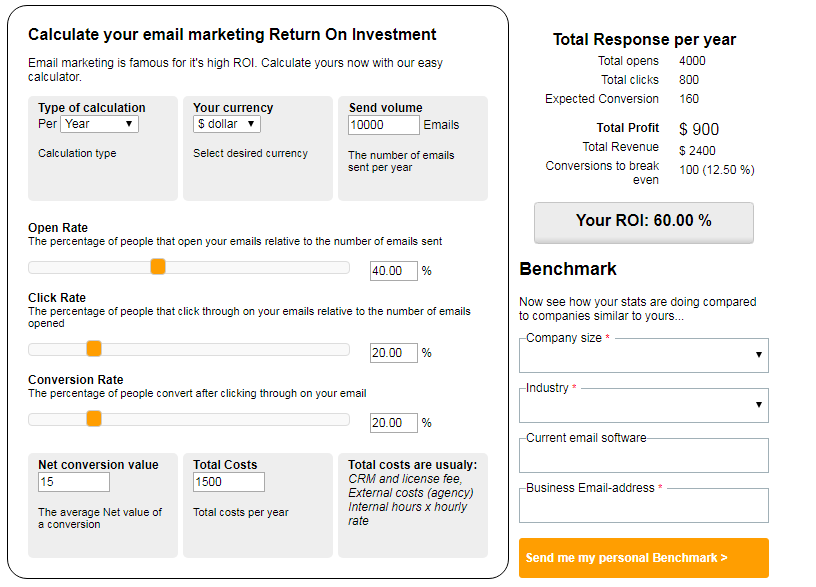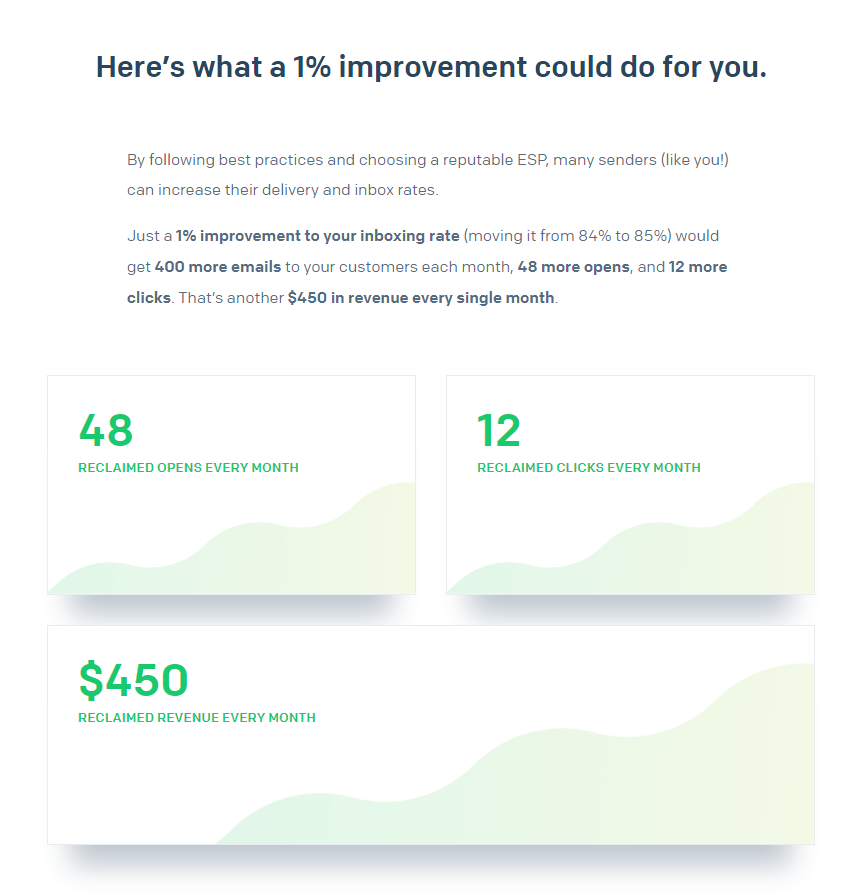Email is considered to be the most effective marketing channel with its return on investment (ROI) of $39.40 per email. Read on to find out how to calculate yours, learn different goals and measurements of the return on email marketing investments, and check several ROI calculators.
What is email marketing ROI
Return on investment, or ROI in email marketing is a performance measure used to evaluate the effectiveness of an investment. Basically, marketers determine what they gained from the investment on email marketing strategy and how much they spent on it.
The basic return on marketing investment formula is as follows:
(Gained – Spent) / Spent = ROI%
Here, we deal with two values — gained and spent — so it’s important to understand what lays behind both of them:
- Gained value shows how much you’ve earned throughout the accounting period. You need to define the exact sources the sales come from. In the case of email marketing, you can use integration with Google Analytics to track how many purchases have been made from a single email. The data can be then collected either for the whole campaign or across a year.
- Spent value demonstrates the amount invested in an email campaign. It includes spends on email service provider, salaries of email marketers, designers, copywriters and other members engaged in bringing your email marketing strategy to life.
Note: You should understand that email marketing needs time to build momentum. So consider at least one year when calculating your email marketing ROI.
Email marketing ROI and how to calculate it
Before you start implementing an email marketing strategy, you need to set measurable goals you want to achieve from your email marketing campaigns. The next step is to develop KPIs that will help you track the progress of your goals along the way.
There are different email marketing ROI goals and measurements. Let’s consider three of them.
Sales and conversions as a part of email marketing ROI
Lead nurturing is like building a long-term relationship: timing and gradualism are everything. Email is an integral part of your gradual moving the leads through a sales funnel up to making a purchase.
To see how email affects your lead nurturing strategy, e.g. sales and conversions, measure engagement, lead acceleration and track impact on revenue:
- Engagement shows how actively customers interact with your emails. To determine whether or not your email engaged customers or deepened relationships, track opens, clicks, unsubscribers, conversions, and click-to-open rate.
- Lead acceleration is a measure that demonstrates how long it took to move users from one stage of the buying cycle to another on their way from a cold lead to a customer. To understand whether or not your email affects lead acceleration, compare how fast a nurtured and non-nurtured lead move along the buying cycle.
- Impact on revenue shows the role of emails in shaping up your company revenue over time across multiple steps of the customer journey — touch points. Such touch points can be your website, email, Facebook page and so on. Assign a value to each of these points in your CRM or email automation system and collect only successful touches — those that led to the action.
Website traffic as a part of email marketing ROI
Bringing traffic back to a website is another email marketing goal. To expand your business and improve awareness, you need to get visitors to your website so that they can get familiar with what you offer. Though there are SEO, social media and search advertisements to help you drive traffic to your website, email marketing can also contribute significantly.
To check how your email campaigns motivate subscribers to visit your website, monitor the following metrics:
- Click-through rate (CTR) — to find out how many customers click on the links in your email. To do that, divide the number of unique clicks by the number of delivered emails and multiply the result by 100%.
- Сlick-to-open rate (CTOR) — to see how many of those who opened your email actually clicked on the links. Divide the number of unique clicks by the number of unique opens and multiply it by 100%.
Both CTR and CTOR help you understand how compelling the content and call-to-action buttons of your emails are. The bigger these metrics are, the more website traffic you get, and the higher your website is ranked in search engines, as a result.
You can go even further and track how many purchases your email subscribers make compared to other website visitors by offering a separate link for your email recipients. However, this doesn’t exclude those who are subscribed to your emails but purchased by simply typing your website or a company name in a search bar.
Brand awareness as a part of email marketing ROI
Brand awareness influences users’ decisions when they hesitate between two different companies. People would rather choose the brand they’ve already heard about than the one which sounds unfamiliar. Email has its share in increasing brand awareness as it helps you reach wider audience, constantly interact with people guiding them through other marketing resources — social media, website, PR publications in different online media, and so on.
There is no single sure way to measure how email increases brand awareness, but you can notice some trends in the following areas:
- Website traffic. Or rather direct website traffic that comes when a person types your website URL directly in their browsers. To determine how your email marketing affects this process, check how many of these visitors are on your mailing list.
- Link building. Check where your external links come from and analyze how many of them can come from the recipients of your email marketing campaigns.
Email marketing ROI calculators
To make the process of measuring basic email marketing ROI easier and faster, use online calculators.
Sleeknote offers an email marketing ROI calculator to answer one simple question: “Are you doing email marketing right?” Choose one of eight currencies and provide the required data:
- send volume;
- cost of campaign;
- open rate;
- click-through rate;
- conversion rate;
- average value of a conversion.
And get the detailed results:
 The results of measuring ROI with Sleeknote calculator
The results of measuring ROI with Sleeknote calculator
It’s a separate website for measuring email marketing ROI. To calculate ROI, you can choose the exact period of time and currency. Then, you need to enter the following data:
- send volume;
- open rate;
- click rate;
- conversion rate;
- net conversion value;
- total costs.
As a result, you get a summary which includes expected conversion, total profit, total revenue, number of conversions needed to break even, and the ROI percentage. There’s also an opportunity to compare your statistics to other companies in your industry by leaving your email.
 ROI calculator on Email Marketing ROI website
ROI calculator on Email Marketing ROI website
SendGrid doesn’t offer you an exact calculation of your email marketing ROI, rather an opportunity to experiment finding out how a 1% improvement to deliverability can raise the return on investment. The tool uses the following values:
- industry;
- monthly send volume;
- current inbox placement rate;
- unique opens;
- unique clicks;
- total monthly revenue from email.
Once you’re done, you can see how the 1% improved deliverability could influence your opens, clicks and ROI. Strong motivation backed up by real numbers.
 ROI calculator results from SendGrid
ROI calculator results from SendGrid
In a nutshell
Email marketing ROI is one of the most significant email metrics that demonstrates the effectiveness of marketing efforts. To count basic ROI, divide the difference between the investment and profit by the amount of investments.
You can also measure other types of email marketing ROI:
- sales and conversions based on engagement, lead acceleration, and impact on revenue;
- website traffic by taking into account click-through and click-to-open rates;
- brand awareness by looking at direct website traffic and external links back to your website.
Use SendPulse to reinforce your email marketing strategy and see your ROI growing!